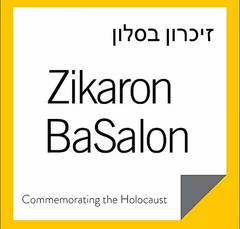- Worship
- Education
- Lifecycle
- Events & Programs
- About Us
- Join Us
- Donate
Yom Hashoah/Zikaron Basalon with Sylvia Rozines
Thursday, April 28, 2022 • 27 Nisan 5782
7:30 PM - 8:30 PMIn-Person and ZoomJoin B’nai Israel member Sylvia Rozines for testimony about her life during the Holocaust as we remember the six million on Israel’s Holocaust Memorial Day–Yom Hashoah. This program is intended for adult members of the congregation. You may attend in-person or join us via Zoom.
Sylvia Rozines was born Syvia Perlmuter on January 20, 1935, in Lodz, Poland. Her father, Isaac, was a salesman, and her mother, Haya, cared for Sylvia and her elder sister, Dora, who was seven years older.
World War II began when Germany invaded Poland on September 1, 1939. Within only seven days, German troops entered and occupied Lodz. The Germans soon enacted antisemitic laws, including those that required all members of the Jewish community to wear the Star of David on the front and back of their clothing. In February 1940, 160,000 Jews were forced to move into the Lodz ghetto. The ghetto was surrounded a barbed-wire fence which separated it from the rest of the city. Food was scarce, and diseases, like typhus, spread throughout the ghetto. Residents of the ghetto were required to work for the Germans. Isaac delivered flour while Haya and Dora worked in a clothing factory, one of ninety-six factories in the ghetto. Sylvia, along with all other Jewish children, was no longer allowed to attend school.
In January 1942, deportations began from the Lodz ghetto to the Chelmno killing center. In the Gehsperre or “general curfew” deportation of September 1942, the Germans searched for and rounded up the children who remained in the ghetto. When the Germans began searching for children street by street, Isaac found hiding places for himself and Sylvia. Isaac often had to secure a new hiding place every day, and on one occasion, they hid in the city cemetery until Dora was able to tell them it was safe. It was dangerous for Sylvia to go outside alone, so when she was not hiding with her father, she spent most of her time with two other Jewish girls who lived in her apartment building. Since most of their toys had been traded for supplies and food, they invented new games and played with dolls made from old sheets to occupy their time.
In August 1944, the Germans began the liquidation of the Lodz ghetto. The remaining 75,000 Jewish residents of Lodz were told to pack their belongings and report to the train station. The majority of the residents were deported to Auschwitz-Birkenau. A small group of adults were selected to stay to clean the ghetto, Isaac, Haya, and Dora were among them. Isaac was able to sneak Sylvia into a cellar when the guards were not watching. Eleven other children were hidden with Sylvia in the cellar while the adults lived in two factory buildings nearby. In the winter of 1944, German guards discovered the children in the cellar, dragged them outside, and allowed them to live with the adults.
On January 19, 1945, the day before Sylvia’s tenth birthday, 800 Jews, including Isaac, Haya, Dora, and Sylvia, were liberated from the Lodz ghetto by the Soviet army. Realizing antisemitism was still rampant in Poland, the Perlmuter family relocated to a displaced persons camp in Germany. From there, they made their way to Paris, where Haya’s brother was living. Sylvia spent her teenage years in Paris until she immigrated to the United States in 1957.
Sylvia married David Rozines, a Holocaust survivor from Poland, in 1959, and they settled in Albany, New York. They had a son and two grandchildren. Sylvia worked in the New York school system for 24 years. Following David’s death, Sylvia relocated to the Washington, DC,  area and is a volunteer at the Museum.
area and is a volunteer at the Museum.
Register below. Zoom link included in confirmation email.

Sorry, Registration has ended.
| Share Print Save To My Calendar |
Fri, April 26 2024
18 Nisan 5784
Livestream
Shabbat Services
Friday at 6:15 PM
Saturday at 9:00 AM
the latest
announcements
Happy Passover from your B'nai Israel Family
We have programming and services throughout the holiday for all ages. Please join us.
Annual Meeting and Hineini Meeting "Thank You" Event on May 20
We are excited to gather our community. Please join for our Annual Meeting and Hineini "Thank You" Event.
Lessans Talmud Torah registration for 2024–2025 is open!
Registering early just got sweeter. Learn more about our program and registration raffle.
B'nai Israel Schilit Nursery School 2024-2025 Program Registration is now OPEN
Our award-winning school can't wait to meet your family. Very limited spaces remain. Learn more. View the beauty of our nursery school ART SHOW.
B'nai Israel First Synagogue in North America to Install RightHear, supporting those who are blind or low vision.
Read our press release here.
NEW Resource: Fighting Antisemitism
Raise Awareness, Educate, and Act to stop antisemitism. Learn more.
Our 2023-2024 Hineini Annual Campaign is Under Way
B'nai Israel is "Here for YOU". Support us today.
Join Our Shabbat Morning Livestream
Click here to access.
Explore Our Exciting Adult Education Offerings
Learn more here.
weekday services
Sunday | 9:00 AM & 8:00 PM
Monday–Thursday | 7:15 AM & 8:00 PM
Friday | 7:15 AM
*Service times vary on holidays.
Click here for access information.
shabbat services
Friday | 6:15 PM (7:00 PM during Summer)
Saturday | 9:00 AM & 12:30 PM (Minha)
Click here for access information.
inclement weather policy
Click here for information.




